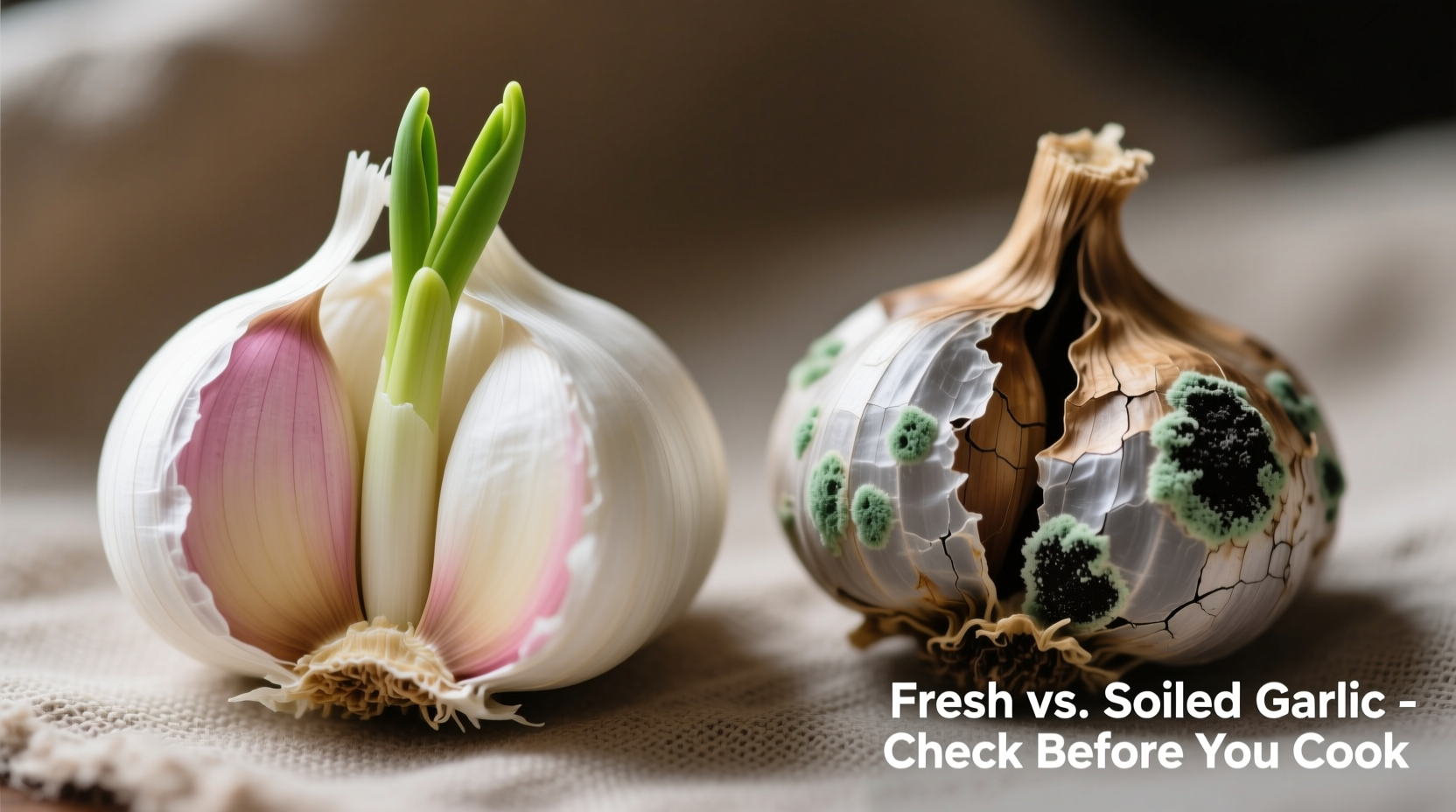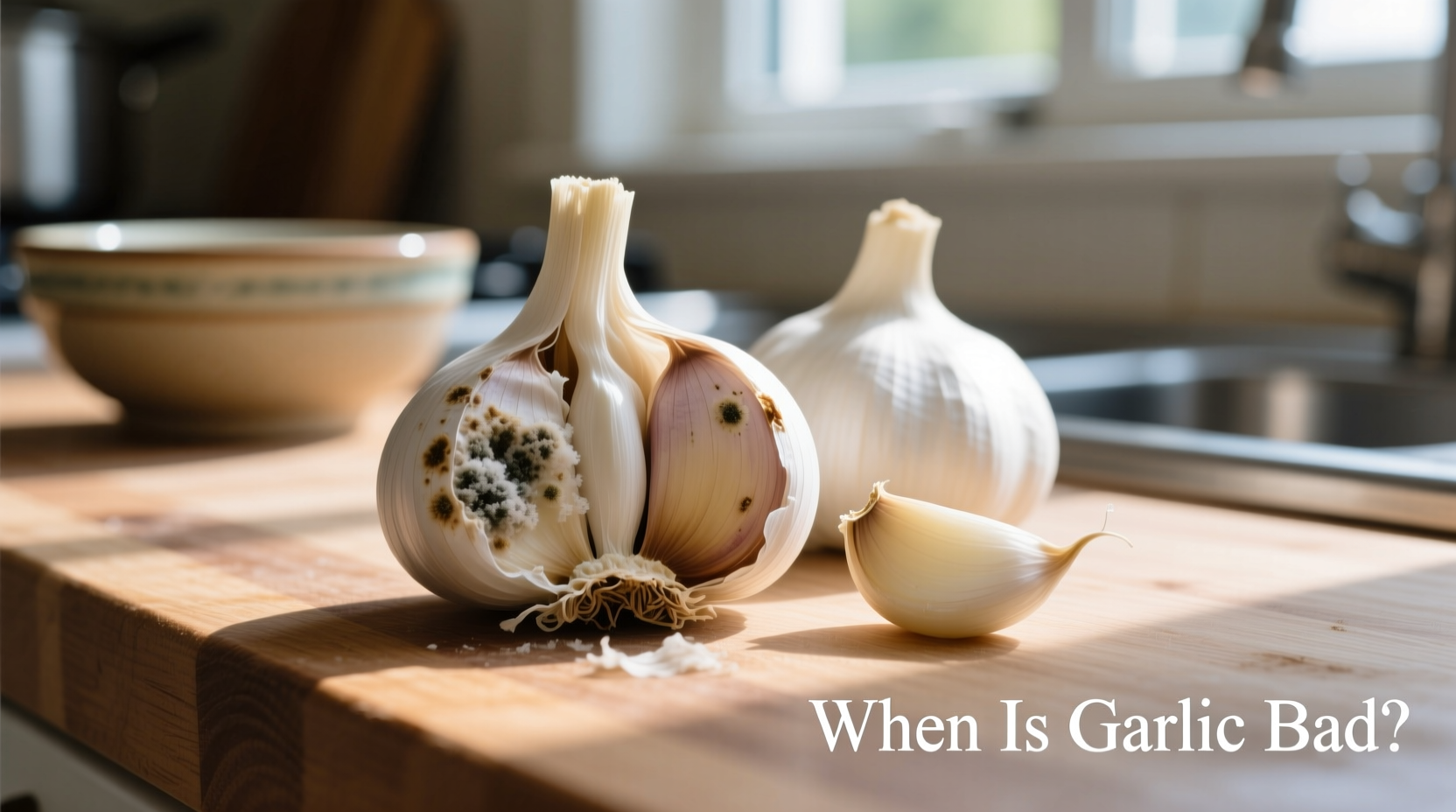As a chef who's handled thousands of pounds of garlic throughout my career, I've seen how often this staple ingredient gets misjudged. Many home cooks toss perfectly good garlic while others risk illness by using clearly spoiled cloves. Understanding exactly when is garlic bad isn't just about flavor preservation—it's a critical food safety issue that affects millions of households.
5 Clear Indicators Your Garlic Has Gone Bad
Don't rely on just one sign—evaluate your garlic using multiple indicators for accurate assessment. Here's what to check:
1. Visual Inspection: What Bad Garlic Looks Like
Healthy garlic should be firm, dry, and paper-thin skin should be intact. Watch for these visual red flags:
- Mold growth (white, green, or black fuzzy patches)
- Dark brown or black spots that penetrate beyond surface level
- Yellowed or discolored cloves with slimy texture
- Excessive sprouting with long green shoots (more than 1 inch)
2. Texture Test: The Touch Method
Fresh garlic should feel rock-hard when squeezed. Press gently on the cloves:
- Soft or mushy spots indicate internal rot
- Wrinkled skin that doesn't bounce back
- Separating cloves that fall apart easily
3. The Smell Check: Your Nose Knows
Cut open a clove if you're uncertain. Fresh garlic has a clean, sharp aroma. Discard immediately if you detect:
- Sour or vinegary smell
- Rancid or musty odor
- Any unpleasant smell different from normal garlic scent
| Garlic Condition | Safe to Eat? | Recommended Action |
|---|---|---|
| Firm cloves, intact skin | Yes | Store properly for future use |
| Small green sprout (less than 1 inch) | Yes | Remove sprout, use immediately |
| Soft spots or mushiness | No | Discard entire head |
| Visible mold growth | No | Discard immediately |
| Yellowed, slimy cloves | No | Discard entire head |
The Science Behind Garlic Spoilage: A Timeline
Understanding how long does garlic last requires knowing its natural deterioration process. According to USDA food safety guidelines, garlic follows this typical spoilage timeline when stored at room temperature:
- Weeks 1-3: Normal aging—slight drying of outer skin is normal
- Week 4: Potential for small green sprouts to appear in center
- Week 5-6: Increased moisture loss, cloves may begin separating
- Week 7+: High risk of mold growth and internal rotting
This timeline varies significantly based on storage conditions. The USDA Food Safety and Inspection Service notes that humidity levels above 70% dramatically accelerate garlic spoilage.

When Sprouted Garlic Is Still Safe to Eat
Many home cooks mistakenly discard garlic at the first sign of sprouting. The University of Georgia Cooperative Extension clarifies that is sprouted garlic safe to eat depends on the sprout's condition:
- Safe to use: Small green sprout (less than 1 inch) with firm, white cloves
- Unsafe to use: Long sprouts with yellowed or soft cloves
To safely use slightly sprouted garlic, simply remove the green shoot (which can taste bitter) and use the remaining clove immediately. Never store sprouted garlic for later use, as the sprouting process indicates the garlic has begun to deteriorate.
Proper Garlic Storage: Maximizing Freshness
Knowing how to tell if garlic has gone bad is only half the battle. Proper storage prevents premature spoilage:
Best Storage Practices
- Store in a cool, dark place with good air circulation
- Use mesh bags or wire baskets instead of plastic containers
- Maintain humidity below 70% to prevent mold growth
- Keep away from heat sources like stoves or dishwashers
Storage Methods Compared
- Pantry (ideal): 3-6 months at 60-65°F with proper ventilation
- Refrigerator: Not recommended for whole bulbs (causes sprouting)
- Freezer: Only for peeled cloves (up to 1 year)
- Olive oil: Maximum 4 days refrigerated (risk of botulism)
The FDA Food Code specifically warns against storing garlic in oil at room temperature due to botulism risk—a serious foodborne illness that can be fatal.
Health Risks of Consuming Bad Garlic
Eating spoiled garlic isn't just unpleasant—it can cause serious health issues. The Centers for Disease Control and Prevention reports that moldy garlic can harbor aflatoxins, which are carcinogenic compounds produced by certain molds.
Symptoms of food poisoning from bad garlic typically appear within 6-24 hours and may include:
- Nausea and vomiting
- Abdominal cramps
- Diarrhea
- Fever
When garlic storage tips to prevent spoilage are ignored, the risk increases significantly. Never attempt to salvage partially spoiled garlic by cutting away moldy sections—microscopic mold threads often penetrate deeper than visible.
When to Toss Your Garlic: Final Decision Guide
Use this practical checklist to determine when to throw out garlic for certain:
- Any visible mold growth (discard entire head)
- Multiple soft or mushy cloves
- Sour or unpleasant odor
- Yellowed or slimy texture
- Excessive sprouting with discolored cloves
When in doubt, throw it out. The minimal cost of replacing garlic is insignificant compared to potential medical bills from foodborne illness. Remember that proper storage extends freshness but doesn't stop the natural deterioration process indefinitely.
Frequently Asked Questions
Can you get food poisoning from bad garlic?
Yes, consuming spoiled garlic can cause food poisoning with symptoms including nausea, vomiting, abdominal cramps, and diarrhea. Moldy garlic may contain harmful mycotoxins, and garlic stored improperly in oil can develop botulism toxin, which is potentially fatal.
Is it safe to eat garlic that has sprouted?
Small sprouts (less than 1 inch) in firm, white garlic are generally safe to eat. Simply remove the green shoot before using. However, if the sprout is long or the cloves have turned yellow or soft, discard the entire head as these indicate advanced spoilage.
How long does garlic last before going bad?
Properly stored whole garlic bulbs typically last 3-6 months in a cool, dark pantry with good air circulation. Once separated, individual cloves last about 7-10 days. Peeled cloves last 1-2 days in the refrigerator. Refrigeration actually shortens shelf life for whole bulbs by promoting sprouting.
What does bad garlic smell like?
Fresh garlic has a clean, sharp aroma. Bad garlic develops a sour, vinegary, or musty smell. If the garlic smells unpleasant or different from its normal scent—especially if it has a rancid odor—it has spoiled and should be discarded immediately.
Can you cut mold off garlic and still use it?
No, you should not cut mold off garlic and use the remaining portion. Unlike hard cheeses or firm vegetables, garlic's structure allows mold to spread internally beyond visible areas. The USDA recommends discarding the entire head if any mold is present due to potential mycotoxin contamination.











 浙公网安备
33010002000092号
浙公网安备
33010002000092号 浙B2-20120091-4
浙B2-20120091-4